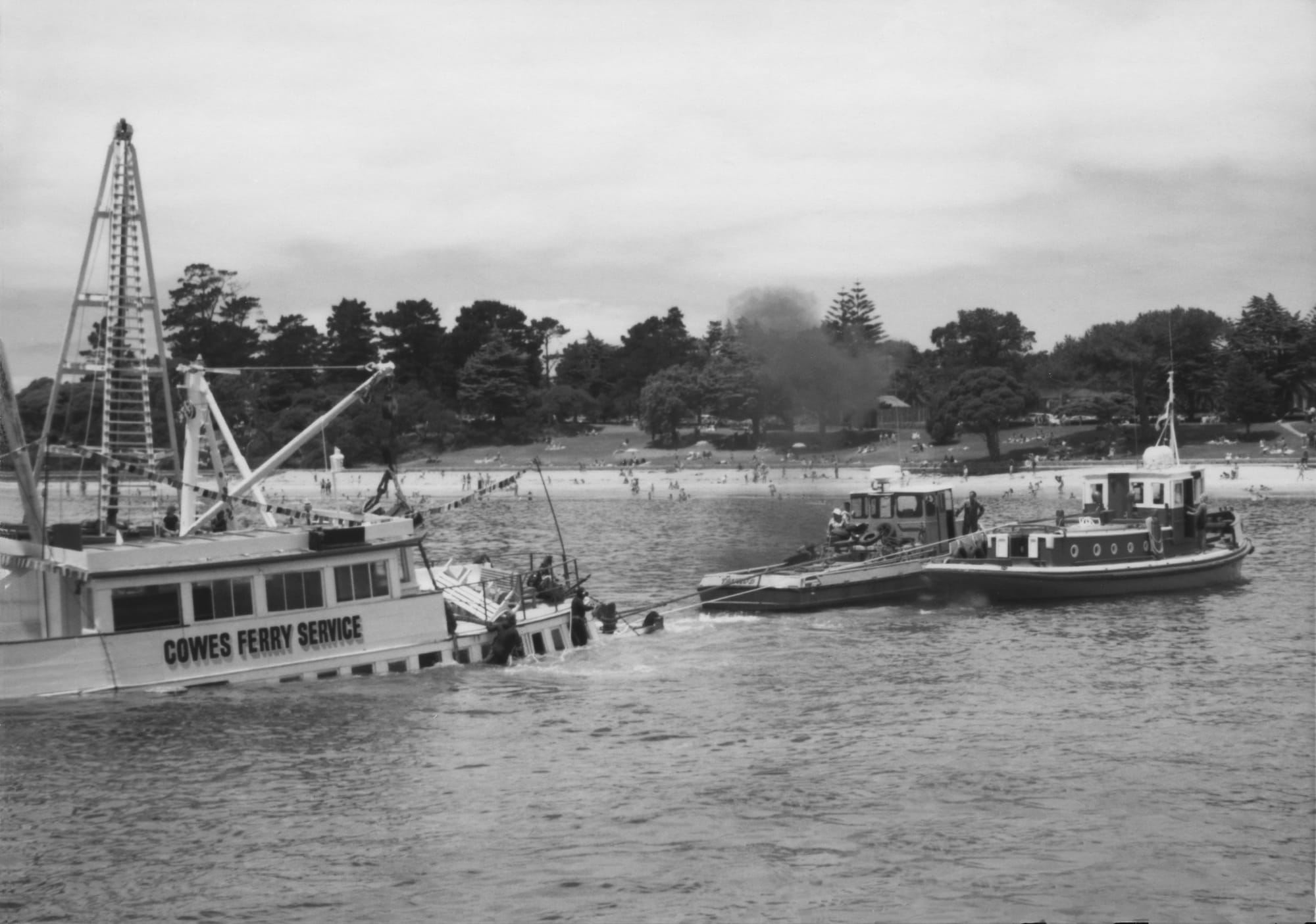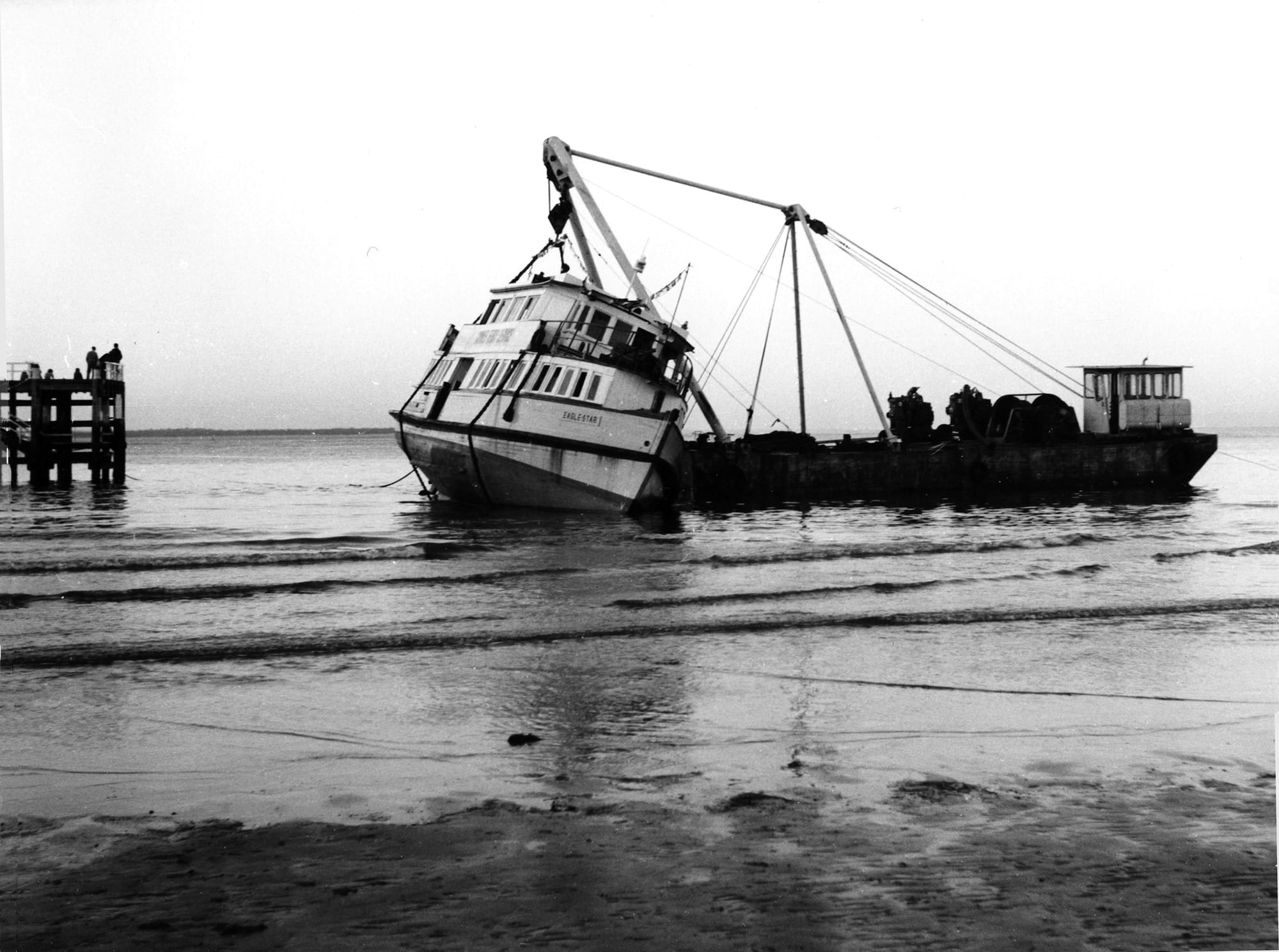On this day, 43 years ago
There were chaotic scenes off the Cowes pier in December 1978, as the Eagle Star ferry went down in 20 feet of water off the Cowes pier with 160 passengers on board.

December 30, 1978, was a pleasant summer day, perfect for a ferry ride across Westernport Bay.
The Eagle Star left from Stony Point on the way to Cowes.
It carried about 160 passengers of all ages, many of whom were probably planning to celebrate New Year’s Eve or start their holidays on the Island.
It was due to arrive at the Cowes jetty at about noon.
When the public address system on board broke down, the ferry master went below to investigate.
He found three feet of water in the hold.
The ferry master reduced speed and started the pumps, but they couldn’t keep pace with the inflow.
He knew the vessel was in trouble, and passengers were immediately brought up from the bottom deck to the upper level.
As the water rose in the boat, it settled lower, dragging the bottom of the passenger doors under the waterline.
Water flooding into the hold killed the motor.
In sight of the Cowes pier, the boat was dead in the water and drifting backwards away from the land.
Meanwhile, over at the Cowes Yacht Club, Ian Samuel, the clubs sailing master, was standing on the beach, supervising learner sailors.
The club’s patrol boat was out on the water to shepherd the learners and assist them if necessary.
Ian noticed the ferry approaching the pier in what he judged was an unusual manner and went up to the radio room at the Clubhouse to take a better look.
What he saw alarmed him.
The ferry was approaching the jetty at speed, and contrary to usual practice, it was approaching at right angles.
He also noticed it was very low in the water.
The ferry was indeed in trouble.
Ian ran up to the observation deck and watched through binoculars while the ferry slammed bow first into the pier, “bounced” back and started to founder.
It was obvious to him that the Eagle Star would not reach shallow water without assistance, and that sinking in 80 feet of water looked inevitable.
A radio message was immediately sent from the Yacht club radio room to its patrol boat, calling for it to give the ferry immediate assistance.
The 21 foot aluminium boat with twin outboard motors was being skippered by Howard Smithson, and manned by Ed Smyth and Manfred Pruter, and was assisting two small yachts near the end of Anderson Street when the call came through.
Help!
The Yacht Club’s log records that a Mayday call from the ferry master was also received by the Yacht Club at 11.48am.
It stated that the ferry “appeared to be in trouble.”
On receiving the call from the Clubhouse, the patrol boat set out for the Cowes jetty.
As the patrol boat was racing to the ferry, a power boat was being launched near the Cowes clubhouse.
The Cee Jay, manned by club members Chris Burgoyne and Neil Beddoe, headed for the ferry to render assistance.
A small U-Drive boat in the more immediate area had already gone to the ferry’s assistance.
It was a gallant try, but the vessel was far too small and low powered to have much effect on the situation.
With the jetty so close, some of the ferry passengers could be seen rushing about in panic, with many going to one side, so that it was in danger of turning over.
In tow
It was a great relief to both those on board and watchers on the pier when the Yacht Club’s patrol boat arrived.
It took over the tow rope and the skipper of the ferry shouted a request to be towed towards the beach.
They made it in tandem past the angled end of the jetty with difficulty, because of the increasing weight of the water in the ferry.
It had managed to drag the ferry to relative safety, into water with a depth of 20 feet, before towing became impossible because of the weight of the water the ferry had taken in.
The important thing was that in the immediate aftermath of the mayday call going out, the patrol boat had managed to stop the ferry from sinking in 80 foot of water.
All decked out with festoons of flags, ready to celebrate New Year’s Eve in Cowes on the following day, the ferry settled stern first in about 20 feet of water, with its bow on a sandbank about 10 feet below the surface.
Its position was on the east side of the Cowes jetty, between the arm of the jetty and the beach.
The ferry listed further, and passengers clinging to the starboard rail on the top rear deck lost their grip, and slithered to the port side.
An attempt was made to launch the life rafts, which were stored on the ferry’s roof, but they slipped overboard, taking the roof rail with them.
May day May day
It was Captain Peters who had sent out the first mayday message from the Eagle Star.
The Western Port Marine Centre across the bay also sent out a Mayday call advising: “All small craft go to the assistance of the Cowes ferry, sinking with 160 passengers on board near the Cowes jetty.”
Their Mayday call was answered in large numbers.
John Jansson was working that day on the Southern Star ferry which was on the way back from a trip to Seal Rocks.
He heard the mayday message come over the radio.


“David Leadbetter was below having a sleep and I was on the wheel,” said John.
“I took her up to full speed and David came up wondering what was going on.”
But it was all over by the time we got back to Cowes, recalls John.
Chaotic scenes
On board as the drama unfolded, passengers were directed to the high side of the boat in an effort to balance it, but the stricken vessel became quite unstable.
Older passengers crowded onto the deck enclosure, and rescue crew in the patrol boat feared that many of them would be trapped inside if the ferry overturned.
Although the ferry was well equipped with lifejackets, rescuers were surprised to see few passengers were wearing them.
As the vessel sank, extra lifejackets were thrown to the passengers from the patrol boat.
Many people, including elderly passengers, jumped overboard and swam for the jetty.
Others swam for the beach.
A terrified man and a small boy were seen trying to climb out of a window.
Small craft and paddlers on boards appeared from everywhere, picking people off the ferry or out of the water, and carrying them to safety.
The Yacht Club’s patrol boat was mobbed by passengers, and nearly overturned.
It had to pull away and take people aboard one at a time.
Crew on the power boats that had raced to the scene called for passengers to jump overboard, so they could be picked up by them.
In fact, these boats had great difficulty manoeuvring their way between the ferry and the beach, because of the fear of injuring the crush of people in the water.
One three week old baby was handed up by a man in the water.
Its mother was one of the passengers taken from the ferry, and carried ashore.
The scene was chaotic.
Witnesses described it as like something out of “Keystone Cops.”
People were jumping overboard or clinging to the ferry and shouting for help.
The water was littered with bobbing heads, luggage, bags, clothing, ferry equipment, paddlers on boards, and small boats.
It was early in the school holidays, and friends and relations of many of the passengers had been waiting on the pier for the ferry to dock.
Hundreds race to the beach
As the news spread across the airwaves (no mobile phones in those days) locals and holiday makers ran down to the foreshore to watch the drama unfold and help if they could.
Some stripped to the basics and plunged in to help pull people out of the water.
Doctors and nurses holidaying on the island, hearing the news flash on their radios, and assuming numerous casualties, rushed to Warley hospital to offer assistance.
The police launch was sent across from Hastings, and the Westernport Bay harbour master arrived from Stony Point on the pilot boat.
Cowes police had responded quickly to the emergency, closing off the pier for the rest of the day, to protect the soggy belongings of passengers as they were salvaged from the water.
The ferry was checked underwater by police divers to make sure no one was trapped inside.
After all the passengers were accounted for, boats on the scene set about the task of collecting life rafts and floating debris and delivering them to the pier.
Miracle
The miracle of that day was that no one was drowned, and only two people were hurt.
An elderly woman was taken to Prince Henry’s hospital with a broken hip.
And the ferry’s skipper was treated for petrol inhalation and shock.
Cause still a mystery
The ferry was eventually refloated and towed to the slipway at Newhaven.
It was later taken to the Tankerton jetty for repairs.
But within a short time, it sank again in very strong winds, and lost its superstructure.
It was towed to Stony Point, then returned to Phillip Island.
The hulk stood off Rhyll for many years.
What caused water to pour into the ferry was never established at the official inquiry which followed.
But a Marine Board inquiry a month prior to the sinking had declared it unseaworthy.
The mystery remains.
Was the ferry still unseaworthy and potentially dangerous before it set out.
Or was it a case of simple human error, and a mistake made?






